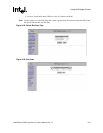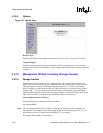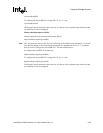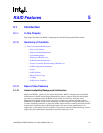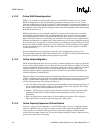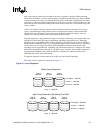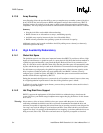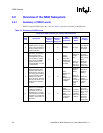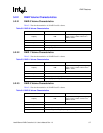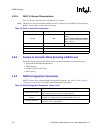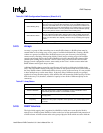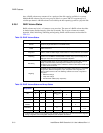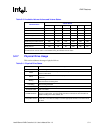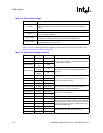
Intel® Server RAID Controller U3-1 User’s Manual Rev 1.0 5-5
RAID Features
transients on the SCSI bus itself and even the best drives and enclosures may not ‘hot swap’
correctly while the bus is experiencing heavy traffic.
5.1.4.3 Auto Declare Spare
If a disk drive is brought online into a system with a degraded volume, SRCU31 will automatically
declare the new disk as a spare and begin rebuilding the degraded volume. The auto declare spare
function requires that the new disk be of equal or greater capacity than the failed disk. Auto declare
also requires that the new disk have a different serial number than the failed disk. If you remove a
drive from a system and reinstall the same drive in the same system, the auto declare will not
declare the reinstalled disk as a spare.
• With a SAF-TE enclosure a bus scan occurs automatically when the drive is inserted. No
manual intervention is required.
• For the Auto Declare Spare feature to work with an enclosure without SAF-TE support, a
reboot or bus scan is required before the system will be able to claim the disk as a spare. See
Section 4.3.9.3, “Bus Scan for more information on using the bus scan feature.
• When inserting a new drive into the enclosure to replace a failed drive, it may have the same
SCSI ID as the failed drive.
5.1.5 System Management
SRCU31 supports DMI and SNMP protocols. In addition, SRCU31 provides a local host monitor
application referred to as RAID Monitor.SeeSection 4.2.1, “RAID Monitor.
5.1.6 What is RAID?
Redundant Array of Independent Disks (RAID) refers to a method of organizing data on one or
more physical disks to provide increased I/O performance and data protection. The different
methods for organizing the data are referred to as RAID Levels. The RAID levels offered by Intel
Server RAID Controller U3-1 are 0, 1, 5 and 10. A summary of RAID levels, their performance
and protection can be found in Table 5-1. RAID levels examples are given in Section 5.2.9.



